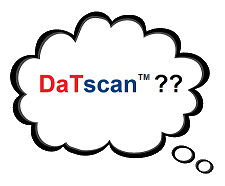 If you’re a Parkinson’s patient, you might have seen or heard the term DaTscan™ . But most people probably have never heard of such a scan (and really, I hope you never do!) But a DaTscan is a Parkie’s friend of sort, since this scan can help in the determination if one may have Parkinson’s disease.
If you’re a Parkinson’s patient, you might have seen or heard the term DaTscan™ . But most people probably have never heard of such a scan (and really, I hope you never do!) But a DaTscan is a Parkie’s friend of sort, since this scan can help in the determination if one may have Parkinson’s disease.
Usual Disclaimer: Again, I am not a physician! This blog simply details my own personal experiences and thoughts. DO NOT use this as medical advice – always seek the advice of your physician or neurologist!
So what is a DaTscan? Well, the DaTscan is a newer scanning procedure that can help confirm a diagnosis of Parkinson’s disease. The scan captures images of the dopamine neurons in your brain. Remember dopamine? That great little neurotransmitter that we Parkies don’t have enough of? These cells, in the Substantia Nigra (SN), are the ones that die off due to the disease. This scan measures how much of those dopamine cells are left.
 My DaTScan Test
My DaTScan Test
It’s an interesting (and somewhat long) test, different than most – I had mine done in 2014. Here’s the story of my DaTscan:
I arrived at the hospital early in the morning and went to the nuclear medicine department (which sounds like something out of the cold war) . First thing they did was give me a most wonderful tasting liquid iodine solution to swallow (blech!) which is supposed to help keep one’s thyroid safe from the injection you get later on. I had to hang around for about an hour while the iodine solution traveled to my thyroid. After that, an IV was inserted and I received the injection of the DaTscan tracer solution itself. I then had wait for 3-5 hours.
Wait? Why? Well, the DaTscan solution (Loflupane I 12) contains a special radioactive isotope that works by binding to Dopamine Transporters (DaT) in the brain’s SN, and it takes that long to travel through your system to that area (sheesh, what did it do, hitchhike?). So what to do in the meantime? Well, the only thing one could do: I headed down to the cafeteria to chow down on some mid-morning brunch (of course, you might do something different depending on how bad your hospital’s food is!)
Once the 3-4 hours were up, I returned to the nuclear medicine department where they make me lie down under a HUGE machine called a ‘Nuclear Medicine Gamma Camera‘ (first thought I had, “I hope this isn’t gonna change me into the HULK! Hmm… then again, that might be cool!“) Once they strapped my head down so it couldn’t move, the gamma camera began turning slowly around my head taking pictures. This took 30 minutes. Then, like that – ta da – I was done, and headed home!
So the procedure isn’t too bad – except for that yucky tasting iodine stuff, and the fact that one can’t move while this giant camera do-hicky – about 1 inch from your head – goes around. (I kept having strange thoughts, like “I really hope whoever put this thing together used some pretty big bolts and screws, cause it would NOT be fun for it to fall on my head!“)
In the end, the scan produces a picture similar to the following:


If the patient has Parkinson’s disease, then the isotope will be deficient in certain areas of the brain. On the other hand, the bigger the ‘tail’ and brighter intensity of the ‘head’ means that the dopamine cells in the Substantia Nigra are working and producing dopamine.
This DaTscan is of both a normal brain on the left, and a Parkinson’s brain on the right; the middle being what I perceive as someone starting to experience the disease. Notice the difference in the size of the tails, and also the intensity of the ‘head’.
 My DaTscan Results
My DaTscan Results
I remember the day well – July 7 2014, at approximately 8:30am. I was sitting at work when the phone rang – it was my neurologist’s nurse. After going into a side room for some privacy, she then told me that my DaTscan had come back abnormal; and that, combined with my neurologist’s examination, told the full story: I had Parkinson’s disease… Needless to say, I didn’t get much done at work that day.
Being curious, later on I went and got the pictures from my scan. When I brought it up on the computer, I did see I was more like a combination of both pictures 2 and 3 above. On the right side of my brain (which controls the left side of the body) I had virtually no tail, but still a somewhat bright core. On the left side, I had a slight tail still showing and the core was still pretty bright. This told me why my symptoms started first on the left side of my body, and the right side had almost no symptoms.
My DaTscan was done in 2014, and since I now have symptoms on both sides of my body, I can only assume that if I had a DaTscan today, it would look very similar to the third picture – which of course is a bummer, but I’ve learned a long time ago that there isn’t anything I can do that will really change things (except keep exercising and hope for that cure!) so why fret over it?

 Another Useful Tool
Another Useful Tool
But the DaTscan, which was FDA approved in 2011, is a newer tool the medical folks can use to help determine if someone may have Parkinson’s. But the DaTscan by itself cannot diagnose Parkinson’s disease. The results of a DaTscan can be used to help rule out other diseases that may have similar symptoms, like essential tremor, especially for individuals early in the course of their disease. For PD, though, it has to be combined with a motion disorder neurologist’s knowledge and tests to confirm or refute their suspected diagnosis of Parkinson’s disease.
As a side note, seeing those pictures always amazes me about the resiliency of the human brain – did you know that one can lose 50% to 90% of their SN before they get any symptoms! The brain, although a problem in PD, is truly an amazing organ!
So now you know all about the DaTscan! If you or your doctor suspects you have PD, they may request this scan – it’s usually paid for by insurance (just make sure your doctor uses the right codes). It’s another tool that will help your neurologist come to a definite conclusion.
That’s it for now! We’ll talk more PD (and other topics) later, so stay tuned!
![]()
![]()



